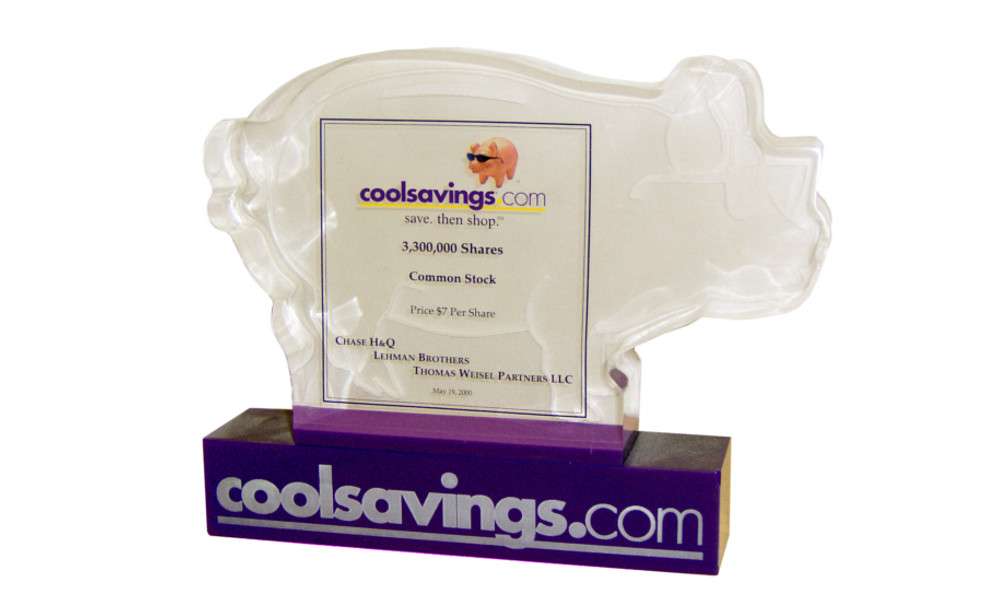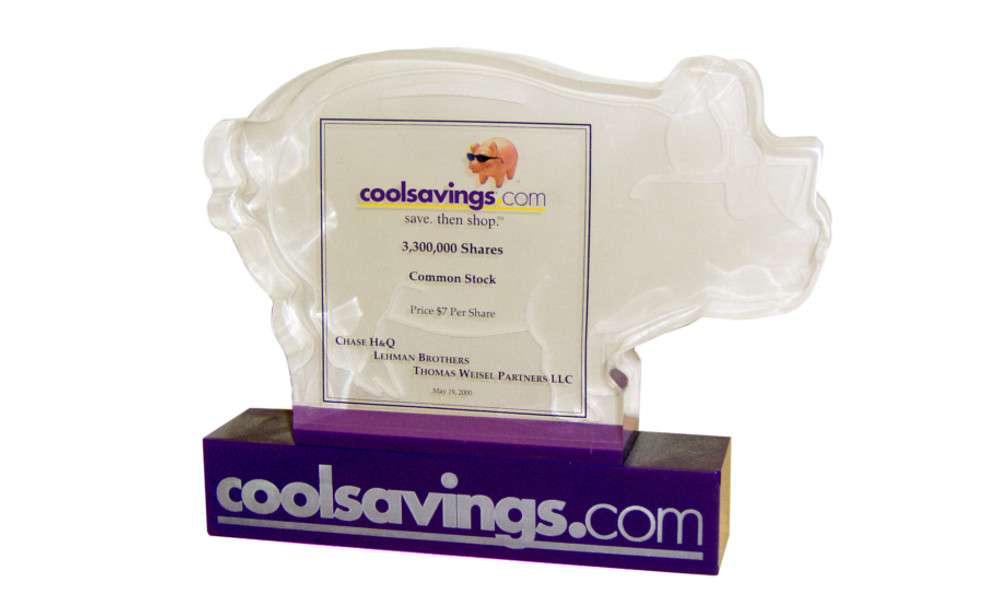Dinosaur Deal Toys: The Case of The Missing Underwriters

In the 40+ years that The Corporate Presence has been designing and producing deal toys, we’ve worked with a large and varied list of clients. Sadly, many of those clients are no longer with us.
As we’ve noted in our installments of the Dinosaur Deal Toys series, those former clients include firms such as Paine Webber, Bear Stearns, Donaldson, Lufkin & Jenrette, and Wasserstein Perella,
It also includes James D. Wolfensohn, Montgomery Securities, NationsBank, Bankers Trust, Wachovia, Alex Brown and Salomon Brothers—to name just a few.
Which brings us to the financial tombstone shown here.
What’s special about this deal toy?
There’s nothing particularly emblematic about either CoolSavings, or the Lucite tombstone that commemorates this offering of its stock.
It seemed almost impossible for any tech company of the 90’s to emerge from the so-called Dotcom Bubble (and resulting Crash) entirely unscathed.
CoolSavings was no exception. But it did survive. And in relative terms at least, merely got its hair mussed.
So why focus on this 23-year-old deal—and its deal toy?
A more compelling aspect of this deal toy—and its underlying deal—might be that none of the three listed underwriters are still in existence.
What happened to them? Find out below.
The CoolSavings Deal Toy and the “Four Horsemen”
The first listed firm, Chase H&Q, had some prior experience as an underwriter.
In fact, in its previous incarnation, as Hambrecht & Quist, the firm had lorded over the tech world as one of the Bay Area’s investment banking “Four Horsemen”.
Founded in 1968 by Bill Hambrecht and George Quist, H&Q had led the public offerings of Silicon Valley companies that were emblematic of both a time and place. These included Apple, Adobe, Netscape, as wall as biotech titan Genentech.
After its acquisition by Chase in 1999, H&Q continued as Chase H&Q before ultimately being absorbed by JP Morgan Chase.
Deal Links to Two Other IB “Horsemen”
There are two other links to the Four Horsemen in this deal.
San Francisco banker Sandy Robertson had grown tired of tech skeptics in his New York-based firm. (In a typical barb, some of his East Coast Smith Barney colleagues disparaged a laser firm involved in one of his deals as the “ray gun company”). In 1969, he formed his own technology-oriented investment bank, Robertson, Colman & Siebel.
Robertson also formed an uneasy relationship with one of his partners, Thomas Weisel. Weisel ultimately left to form his own firm. Weisel’s new firm was called Montgomery Securities. Robertson’s reconstituted firm became Robertson Stephens.
The two former colleagues and their firms would maintain an intense rivalry. Together they would also comprise two of the Four Horsemen. (Ironically, through a series of subsequent mergers, the two warring horsemen would almost find themselves thrown together in the same corporate stable).
After Montgomery was acquired by NationsBank, Weisel founded the firm listed here, one that would be more commonly known as TWP. Thomas Weisel Partners was itself acquired by Stifel in 2010.
The Weisel name carried some obvious cachet. It lives on as the “TWP” wealth management division of Stifel.
Lehman Brothers: The Final Deal Toy Casualty
You get a sense of the epic sweep of the collapse of the final underwriter, Lehman Brothers, in the recent play chronicling the firm’s 163-year history. “The Lehman Trilogy” was originally written in Italian, translated into French, and then adapted and staged in London, all en route to an eventual Broadway production.
The bank’s fate has been endlessly researched, recounted, documented, analyzed, and revisited.
We had our own unique perspective on the firm’s demise. Lehman had been a longstanding client of The Corporate Presence. It had, in fact, been our largest client. (It was a measure of the deep business and personal ties we had with the firm that, in the aftermath of the 9/11 attacks, we provided space in our New York office for some of Lehman’s displaced art and graphics staff).
At the time of its bankruptcy filing on September 15, 2008, Lehman had been the 4th largest U.S. investment bank. It had $639 billion in assets, and 25,000 employees worldwide.
What Happened to CoolSavings?
So, what happened to CoolSavings, which, after all, was the focus of both the deal and deal toy?
As its name and piggybank logo suggest, the company sought to save both consumers and retailers time and money via a proprietary, coupon-based, online matching network.
But only a year after its 2000 initial public offering , the company faced the prospect of delisting on NASDAQ.
Having weathered patent challenges, cash constraints, and a declining stock price, CoolSavings changed its name to Q Interactive in 2006. In 2016 it was acquired by Fluent.
Contact Us For a Quote Today
"*" indicates required fields
